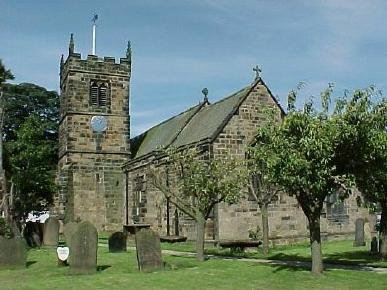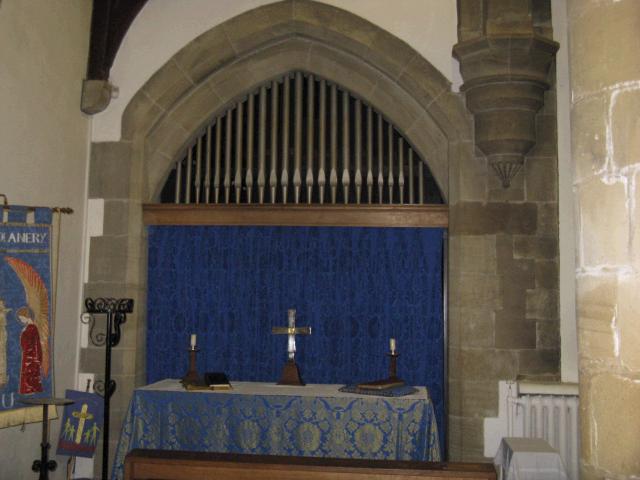 |
 |
 |
| Brief History of Brompton Churches | The Tower |
|---|---|
| The Saxon Crosses | The Cock Shaft |
| The Wheel Head Crosses | The Hogback Stones |
| Early Developments | John Kettlewell and Restoration |
 |
 |
The Methodist Church and St. Thomas' Church,
|
||||
|---|---|---|---|---|
| Home | St Thomas' Information |
How to find the churches |
Methodist Information |
Songs of Praise at The Orchards |
| Mothers & Others | Sunday School |
Youth Fellowship (B.E.Y.F.) |
Brompton Fellowship | Mothers' Union |
| Photographs |
Events and Service Times |
- | - | Links to others in Brompton |
|
||||
In York, the concentration of population allowed the masons’ yards to mass-produce standard grave-slabs for the
churches of the city while out in the country workshops had to serve a much wider area embracing several villages,
a fact which is betrayed by the use of the same distinctive template to provide both the outline of a warrior’s
helmet on a cross at Sockburn and the curved breast of a bird on the cockshaft here at Brompton some seven miles away.
The quantity of carving is impressive, but what makes it so useful for the historian and the archeologist is
that sculpture is a relatively immobile art. The styles and geology of the stones show that they were usually
carved in or near the church where they are now found. As a result the carvings give us valuable insights
into the political groupings and cultural tastes, the economic links and religious beliefs of a wide range
of communities where no other record was left in any contemporary source and Brompton is believed to have been
a site of ‘manufacture’ of these artefacts.
The most unusual monuments from the Pre-Conquest period are the Hogback Stones, ten of which were found at Brompton.
Five still remain here in the Church whilst the other five are in Durham Cathedral Library. These formed
part of a burial site, probably lying along the tomb and being approximately four feet in length. This type
of shrine tomb is to be found only in Cumbria, Cornwall,, North Yorkshire and parts of Scotland; the Brompton
examples being particularly fine.
The Hogbacks are some two feet in height. The two extremes are usually terminated by the carved figures
of two hogs lying on their backs and gnawing at a long plait which runs the length of the top surface: hence
the name ‘Hogbacks’, however, the Brompton examples depict muzzled bears. In places the stone is picked to
suggest the texture of fur. The sides of the stones, which taper towards the plait, are finished with stylised
interpretations of roof tiles and at least one of the Brompton examples shows an arch-shaped opening on the face,
probably representing the door of a house.
Mr. Allan Romilly, in his study of similar stones in Scotland, traces the development of hogbacks from third century
Christian sarcophagi found in the eastern Mediterranean, which also take the form of a pitched roof tombstone
. Thus, whilst the hogbacks appear to follow in the tradition of the Pagan ‘House of the Dead’, it is
interesting to speculate that they could be a combination of Christian and Pagan beliefs. The boar or hog
was sacred to the Pagan god, Frey. The association of the hogbacks with a site known to have been Christian
since the 6th century, namely the site of St. Thomas’ Church, together with the fact that Christianity remained
in existence during this ‘Dark Age’, proved by the fact that the See of York continued to operate for all but a
brief period, suggests a continuation of the Christian usage of the site. It is not known exactly where the
hogbacks were originally sited, as they were found as part of the chancel foundations in 1867, prior to the
refurbishment of the fabric, and they could easily have been brought to the site when the chancel was built in
stone in the 12th century. Further research may throw some light on this issue.
The Hogbacks
England had long been a Christian country when the Scandinavian settlers arrived, and sculpture in stone was
one of its distinctive religious arts. The walls of Anglo Saxon monastries were decorated with stone friezes
and panels; the relics of saints rested beneath stone shrines; free standing crosses stood as objects of
contemplation at sacred sites; and crosses and slabs marked the graves of the Christian dead.
By contrast, the pagan settlers who came to Britain had no such tradition of carving in stone.
We might, therefore, have expected that the art of sculpture would die with the new political and social order.
Yet, paradoxically, the Viking settlement gave it renewed life. New kinds of decoration were introduced alongside
traditional English motifs and new forms of ornament were developed. There was also a startling increase in the
popularity of sculpture and this has left us with a huge quantity of Viking Age carving scattered across the
churches in northern England. In Yorkshire alone the remains of more than 500 monuments still survive giving us
to believe that a spirit of compromise seems to have governed relations between the Christian church and the
new settlers.
 |
 |
 |
| Brief History of Brompton Churches | The Tower |
|---|---|
| The Saxon Crosses | The Cock Shaft |
| The Wheel Head Crosses | The Hogback Stones |
| Early Developments | John Kettlewell and Restoration |
 |
 |